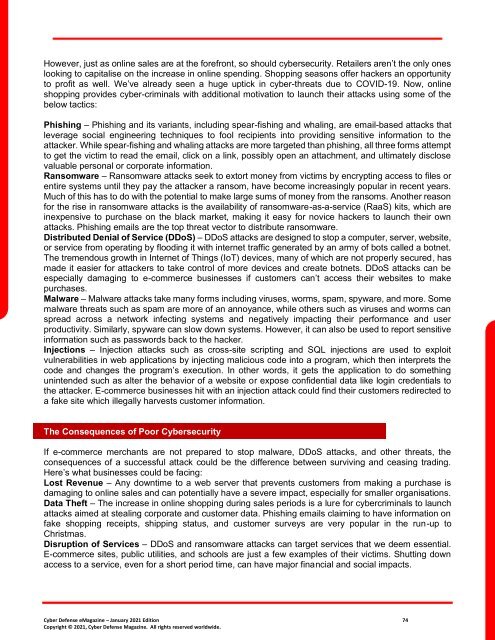Cyber Defense eMagazine January 2021 Edition
Cyber Defense eMagazine January Edition for 2021 #CDM #CYBERDEFENSEMAG @CyberDefenseMag by @Miliefsky a world-renowned cyber security expert and the Publisher of Cyber Defense Magazine as part of the Cyber Defense Media Group as well as Yan Ross, US Editor-in-Chief, Pieruligi Paganini, Co-founder & International Editor-in-Chief, Stevin Miliefsky, President and many more writers, partners and supporters who make this an awesome publication! Thank you all and to our readers! OSINT ROCKS! #CDM #CDMG #OSINT #CYBERSECURITY #INFOSEC #BEST #PRACTICES #TIPS #TECHNIQUES
Cyber Defense eMagazine January Edition for 2021 #CDM #CYBERDEFENSEMAG @CyberDefenseMag by @Miliefsky a world-renowned cyber security expert and the Publisher of Cyber Defense Magazine as part of the Cyber Defense Media Group as well as Yan Ross, US Editor-in-Chief, Pieruligi Paganini, Co-founder & International Editor-in-Chief, Stevin Miliefsky, President and many more writers, partners and supporters who make this an awesome publication! Thank you all and to our readers! OSINT ROCKS! #CDM #CDMG #OSINT #CYBERSECURITY #INFOSEC #BEST #PRACTICES #TIPS #TECHNIQUES
You also want an ePaper? Increase the reach of your titles
YUMPU automatically turns print PDFs into web optimized ePapers that Google loves.
However, just as online sales are at the forefront, so should cybersecurity. Retailers aren’t the only ones<br />
looking to capitalise on the increase in online spending. Shopping seasons offer hackers an opportunity<br />
to profit as well. We’ve already seen a huge uptick in cyber-threats due to COVID-19. Now, online<br />
shopping provides cyber-criminals with additional motivation to launch their attacks using some of the<br />
below tactics:<br />
Phishing – Phishing and its variants, including spear-fishing and whaling, are email-based attacks that<br />
leverage social engineering techniques to fool recipients into providing sensitive information to the<br />
attacker. While spear-fishing and whaling attacks are more targeted than phishing, all three forms attempt<br />
to get the victim to read the email, click on a link, possibly open an attachment, and ultimately disclose<br />
valuable personal or corporate information.<br />
Ransomware – Ransomware attacks seek to extort money from victims by encrypting access to files or<br />
entire systems until they pay the attacker a ransom, have become increasingly popular in recent years.<br />
Much of this has to do with the potential to make large sums of money from the ransoms. Another reason<br />
for the rise in ransomware attacks is the availability of ransomware-as-a-service (RaaS) kits, which are<br />
inexpensive to purchase on the black market, making it easy for novice hackers to launch their own<br />
attacks. Phishing emails are the top threat vector to distribute ransomware.<br />
Distributed Denial of Service (DDoS) – DDoS attacks are designed to stop a computer, server, website,<br />
or service from operating by flooding it with internet traffic generated by an army of bots called a botnet.<br />
The tremendous growth in Internet of Things (IoT) devices, many of which are not properly secured, has<br />
made it easier for attackers to take control of more devices and create botnets. DDoS attacks can be<br />
especially damaging to e-commerce businesses if customers can’t access their websites to make<br />
purchases.<br />
Malware – Malware attacks take many forms including viruses, worms, spam, spyware, and more. Some<br />
malware threats such as spam are more of an annoyance, while others such as viruses and worms can<br />
spread across a network infecting systems and negatively impacting their performance and user<br />
productivity. Similarly, spyware can slow down systems. However, it can also be used to report sensitive<br />
information such as passwords back to the hacker.<br />
Injections – Injection attacks such as cross-site scripting and SQL injections are used to exploit<br />
vulnerabilities in web applications by injecting malicious code into a program, which then interprets the<br />
code and changes the program’s execution. In other words, it gets the application to do something<br />
unintended such as alter the behavior of a website or expose confidential data like login credentials to<br />
the attacker. E-commerce businesses hit with an injection attack could find their customers redirected to<br />
a fake site which illegally harvests customer information.<br />
The Consequences of Poor <strong>Cyber</strong>security<br />
If e-commerce merchants are not prepared to stop malware, DDoS attacks, and other threats, the<br />
consequences of a successful attack could be the difference between surviving and ceasing trading.<br />
Here’s what businesses could be facing:<br />
Lost Revenue – Any downtime to a web server that prevents customers from making a purchase is<br />
damaging to online sales and can potentially have a severe impact, especially for smaller organisations.<br />
Data Theft – The increase in online shopping during sales periods is a lure for cybercriminals to launch<br />
attacks aimed at stealing corporate and customer data. Phishing emails claiming to have information on<br />
fake shopping receipts, shipping status, and customer surveys are very popular in the run-up to<br />
Christmas.<br />
Disruption of Services – DDoS and ransomware attacks can target services that we deem essential.<br />
E-commerce sites, public utilities, and schools are just a few examples of their victims. Shutting down<br />
access to a service, even for a short period time, can have major financial and social impacts.<br />
<strong>Cyber</strong> <strong>Defense</strong> <strong>eMagazine</strong> – <strong>January</strong> <strong>2021</strong> <strong>Edition</strong> 74<br />
Copyright © <strong>2021</strong>, <strong>Cyber</strong> <strong>Defense</strong> Magazine. All rights reserved worldwide.


















